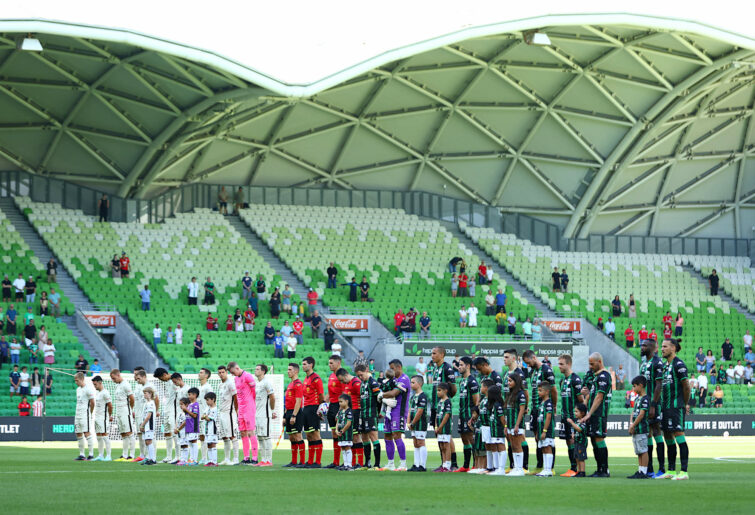In roughly 18 months, our beloved A-Leagues are all-but set to expand. Canberra, Australia’s capital, and Auckland, New Zealand’s most populous city, have been earmarked by the Australian Professional Leagues (APL) as preferred locations for expansion.
This would bring the number of A-League franchises to 14 by 2024-25 (pending investor interest).
Just a year following this (2024-25), the APL have outlined lofty plans to introduce a further two teams. Reading between the lines per various reports, a franchise from southeast Queensland is almost guaranteed to take one of these two spots (a Gold Coast or second Brisbane side seem destined to compete in a two-horse race, although Sunshine Coast could be an outsider).
Meanwhile, the 16th and final spot appears destined for a hard-fought slog between Wollongong, a second Perth team, a second Adelaide team, or Tasmania. Darwin, as suggested elsewhere, is a rank outsider.
Assuming this bold plan materialises unencumbered, Australian (and New Zealand) football could realistically have between 28-32 professional teams by as soon as 2025, with the much-anticipated National Second Tier (NST) set to launch in 2024. That’s pending approval from Football Australia (FA), whom (at time of writing) are currently undertaking their due diligence on 32 NST Expressions of Interests (EOIs).
Promotion and relegation between the A-League Men (ALM) and NST could conceivably take place as soon by 2026, although it is more likely to be introduced later, once the financial sustainability and stability of the NST (and ALM, for that matter) are assured (perhaps, in this writer’s opinion, by 2030).
It truly is an exciting time to be a football fan in Australia, let alone an A-League supporter. However, a concerning apathy towards the ALM has lingered in the public consciousness in recent years, exemplified throughout social media circles, everyday word-of-mouth (or lack thereof), and an Australian sporting media which has broadly demonstrated a lethargic interest (at best) for the competition.
Yet rusted-on fans of the A-Leagues are not immune to criticism, however.
Us passionate fans of the A-Leagues and Australian football have an irritating tendency to focus inordinate amounts of energy on the negatives without giving due acknowledgement of the positives.
Issues like the A-Leagues’ Grand Final being moved to Sydney for three years, the lack of a pause and rewind function on Paramount Plus, and the poor crowds of Western United and Macarthur FC seem to perpetuate a negative discourse of football in Australia.
This simply does not match the objective reality: a reality in which the positives far outweigh the amplified negatives, yet are oft forgotten in the seemingly perpetual fog of hopelessness which at present shrouds our collective soccer sentience.
The exciting A-Leagues expansion and NST developments represent just the tip of the iceberg, the foundations of which have been solidifying and forming as early as 2018.

(Photo by Albert Perez/Getty Images)
Crucial and oft forgotten events in the round-ball code at this time begin with the end of the two-year long struggle for control of the game, resulting in the then-Football Federation Australia (FFA) finally expanding its congress from ten members to a more-representative 28 members, encompassing all stakeholders (state body members, A-Leagues club members, a players’ member, and women’s football council members).
This set forth the unbundling of the leagues from then-FFA, resulting in the APL: a newly formed independent entity which has operational and commercial control of the leagues.
The APL, having been given the keys to the ‘A-League kingdom’ during a deadly pandemic, and despite the occasional misstep (rightfully cue the Sydney grand final decision), have by-and-large performed exceptionally in an operational capacity. A specific case-by-case examination is needed here:
In 2021, the APL secured a $200 million, 5 (+3) year broadcast deal with Network 10 (Viacom CBS) and Paramount Plus. This season, two out of six ALM matches are broadcast HD on free-to-air (FTA) television (on Ten Bold), up from one last season (albeit on Ten’s main channel).
In the 10 years prior, the A-Leagues’ presence on FTA was inconsistent at best, being simulcast from Fox Sports on ABC, 10, and SBS (often on the secondary SD Viceland channel). Before 2012, the ALM was not even broadcast on FTA television.
The same year, the APL rebranded the A-League and W-League into the A-League Men and A-League Women (ALW), representing a progressive move to equalise the two competitions under a unified banner (which was even applauded by FIFA).
The APL also acquired two new headline sponsors for their two competitions: Isuzu Ute and Liberty (it should not be forgotten that the ALM was sponsor-less for a period once Hyundai’s deal expired). The APL also reintroduced the A-League All Stars concept last year, which in 2023 could see the world’s most lucrative football team Paris Saint-Germain on our shores, and provide the next Garang Kuol a chance to prove himself on the world stage.
Financially, the club-owners and prospective investors have loosened their purse-strings, seeing very-real investment into the competition, most prominently the mammoth $130 million investment by US private equity firm Silver Lakes.
This investment gave rise to digital investment, including: the A-Leagues KEEPUP digital hub which, as of 2023, is in very good working order (and including A-Leagues’ fantasy competitions); the fantastic doco-series A-Leagues All Access; dedicated official A-Leagues podcasts and a mid-week Network 10 magazine show (Round Ball Rules), and even the E-Leagues competition.
A strong digital presence has never been a fait-accompli, but is certainly now making strides.
Lastly, a conglomerate of A-League club owners have even propped-up the ownerless Newcastle Jets indefinitely. The medium-long term financial security of the league, on paper at least, has arguably never been stronger.
This laid-groundwork should have given the APL and A-Leagues close to a decade of breathing space to bring the leagues back to the famed glory days.
However, our collective attention spans are short, and our patience is worn-down and razor thin. The chorus of disapproval remains either loud or lethargic, with hope brittle. What about the poor crowds?
Well, this can also be accounted for.
Bums on seats, arguably the most decisive indicator of the competition’s success (which APL CEO Danny Townsend himself has numerously stated) is often measured through a general holistic lens, such as league-wide crowd averages, without giving due consideration of the case-by-case factors affecting each club.
This big-picture perspective misrepresents the relative strength of crowd numbers, and a more specific analysis is required to understand the full picture.
In essence, the poorest-performing club crowd attendances have struggled with various off-field complications and distractions (as a result of COVID or otherwise) in recent years which has significantly skewed average crowd numbers.
Perth Glory have played away from home for much of this season, which follows two COVID-affected years relocated to the eastern states. The Roar have played an hour north of Brisbane for the past three seasons to save on exorbitant rental costs at Suncorp Stadium.
Western United have played practically everywhere but their represented area in West Melbourne (& greater west Victoria) in their 3.5 seasons as they await completion of their precinct (and official stadium construction). Macarthur FC, it should be remembered, launched during COVID-19 in 2020-21, and in this writer’s opinion, have earned a few more years to grow their fanbase.
A club less deserving of sympathy (but still worthy of mention) is Melbourne Victory being imposed sanctions and crowd caps (specifically on active support) for the remainder of the season (we all know why).

(Photo by Graham Denholm/Getty Images)
Meanwhile, the unaffected clubs have had very minimal loss in crowd figures (if any).
Adelaide United and the newly-returned-home Sydney FC have been standard-bearers for the competition this season, with Western Sydney not far behind. Meanwhile, Newcastle, Mariners, Phoenix and City round out the rest with unspectacular yet respectable crowd numbers this season.
Whilst next year, Perth will play every game at their home stadium, Brisbane will reportedly return to Suncorp or the more appropriately-sized Ballymore, Victory will be unimpeded by crowd-capacity limitations in the active support area, whilst Western United will (almost certainly) play out of their 5,000-precinct in Tarneit.
It would be naïve to dismiss the number of challenges the A-Leagues face (eyeballs on TV remains a significant one), but the purpose of this article is to demonstrate the equal naivety of dismissing the very real reasons for optimism which is forgotten in current A-League discourse.
This article has not even had time to highlight and emphasise the broader (non A-League) Australian football happenings to look forwards to, which will almost certainly translate to A-Leagues growth.
The most obvious of these is the FIFA Women’s World Cup on home soil in less than 4 months and the fierce growth of women’s football (including plans for a Women’s Australia Cup, ALW expansion, a Women’s Asian Champions League, and eventually a women’s NST – all of which deserve their own article for analysis).
Association football remains the largest junior participation sport in Australia by a country-mile. The AFC Asian Cup and Summer Olympics will take place in 2024, generating further interest in the sport domestically.
The A-Leagues and football in Australia is in good stead with a solid foundation and plenty of positives.
And hopefully the exciting expansion news snowballs into something wonderful.
Let’s let ourselves be excited once more.






























































































